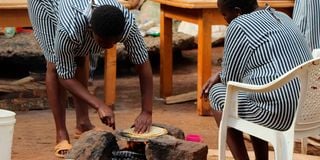State should rethink gender-responsiveness in Kenyan Prisons

Female inmates prepare chapati at Murang'a Prison in this file photo. The Department of Correctional Services should appeal to the Judiciary to consider that majority women are imprisoned for petty offences.
What you need to know:
- Relevant literature indicates that when held in custody in the same facility with men, women prisoners are exposed to physical and sexual attacks.
- Gender responsiveness begins with a gender policy and action plan that clearly defines issues to address.
The Principal Secretary for Correctional Services, Mary Muthoni, was reported on the Daily Nation (January 3, 2023) imploring the Judiciary to accelerate cases of women with babies in remand so as to return the infants to a normal environment.
This happened after she encountered a four-day old infant at Embu Prison, thanks to the mother’s incarceration. Ms Muthoni said such children are exposed to infections and are likely to be stigmatised for no fault of their own. She revealed that her department had initiated day-care centres for them.
This brings into focus the gender-sensitivity of correctional services. It will be remembered that the Kenya Prisons Service (KPS) launched reforms to align with human rights standards during Moody Awori’s tenure in the concerned Ministry. The reforms included introduction of dignified uniform and transport facilities as well as family days to maintain prisoners’ family connection.
There were even plans to have prisoners exercise their conjugal rights. KPS’ current strategic plan and service charter do not mention any commitment to gender responsiveness. The only such reference is the plan to address gender-based violence.
Relevant literature indicates that when held in custody in the same facility with men, women prisoners are exposed to physical and sexual attacks. More often than not, the women have young children that directly depend on them for survival.
Gender policy
Such children are prisoners by default, and in a facility not appropriate for their age and needs. Profiles of women prisoners also show that they have been victims of rape, battery or other violence hence, need specialised rehabilitation.
Gender responsiveness begins with a gender policy and action plan that clearly defines issues to address.
For instance, is the number of women’s prisons adequate for those convicted? Do they facilitate access to sexual and reproductive health services and products and professional ante-natal and post-natal services? Do the prisons have childcare facilities like breastfeeding rooms? Are the pregnant and lactating prisoners provided with appropriate diets and protected from hazardous work? Do they have women officers trained on human rights standards? What measures are in place to ensure prisoners are protected from sexual exploitation by prison staff and coerced lesbianism among themselves? Are the physical searches and pregnancy tests dignified or are they invasive? Are the prisoners offered optional vocational training courses or consigned to feminised trades such as tailoring, beauty therapy and nutritional services? Are male prisoners protected from bullying, battery and sodomy by fellow inmates?
Luckily, there are international and regional guidelines on correctional services responsive to women’s needs, which can be used to audit and improve Kenya’s services. The United Nations (UN) Rules for the Treatment of Women Prisoners and Non-custodial Measures for Women Offenders (Bangkok Rules) of 2011 encourages member states to adopt legislation towards establishment of alternatives to imprisonment and collect, maintain, analyse and publish data on women in prison.
The rules require preferential use of non-custodial measures for pregnant women or caregivers of infants, with imprisonment being applied only where the offence is serious or violent.
Pregnant prisoners
The UN Standard Minimum Rules for the Treatment of Prisoners requires the physical separation of male and female inmates, special accommodation for pre-natal and post-natal care and treatment, and arrangements to have children from pregnant prisoners born outside the penitentiary. It further stipulates that birth certificates of such children should not disclose that they were born in prison. Institutions holding such children must establish a nursery with qualified staff to take care of them.
The women’s prison should be under the authority of a responsible female officer and no males are allowed entry unless they are professionals, like doctors on official duty.
At the continental level are the Guidelines on the Conditions of Arrest, Police Custody and Pre-trial Detention, which require provision of facilities to meet women’s hygiene needs, gender-specific health screening and care, and the right to be seen by a female medical practitioner. They also require access to obstetric and paediatric care.
As the Department of Correctional Services matures the day-care initiative, it should also appeal to the Judiciary to consider that majority women are imprisoned for petty offences, especially those related to selling traditional brews namely chang’aa and busaa. They do this out of necessity and lack of alternatives. Is imprisonment the best for them?
Prisons must also consider that maintaining a binary system of facilities exposes inter-sex persons to violation by staff and inmates. To start off, KPS could audit its gender-responsiveness using the international and regional instruments.
Dr. Miruka is an international gender and development consultant and scholar ([email protected])





